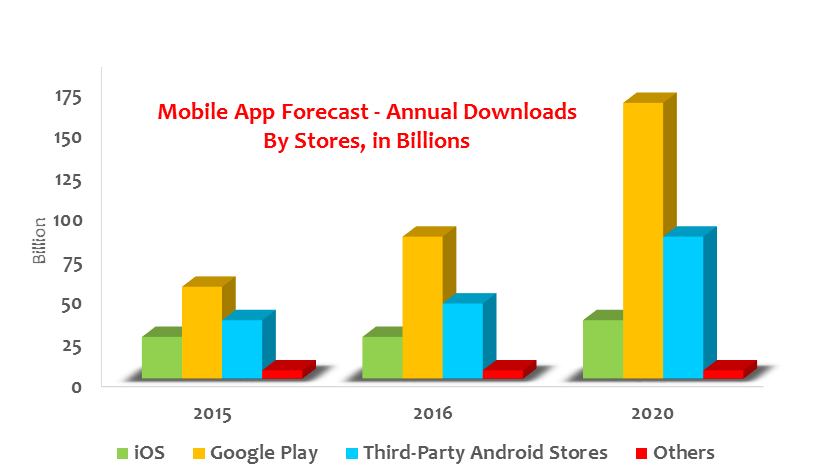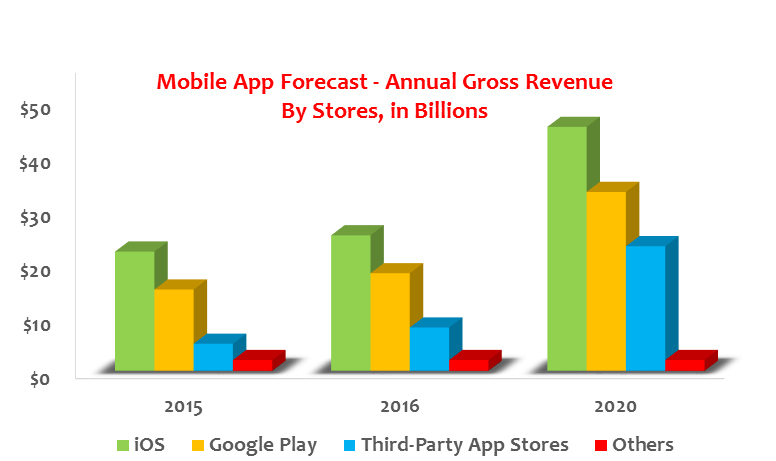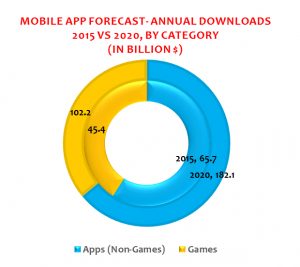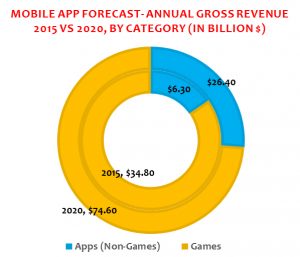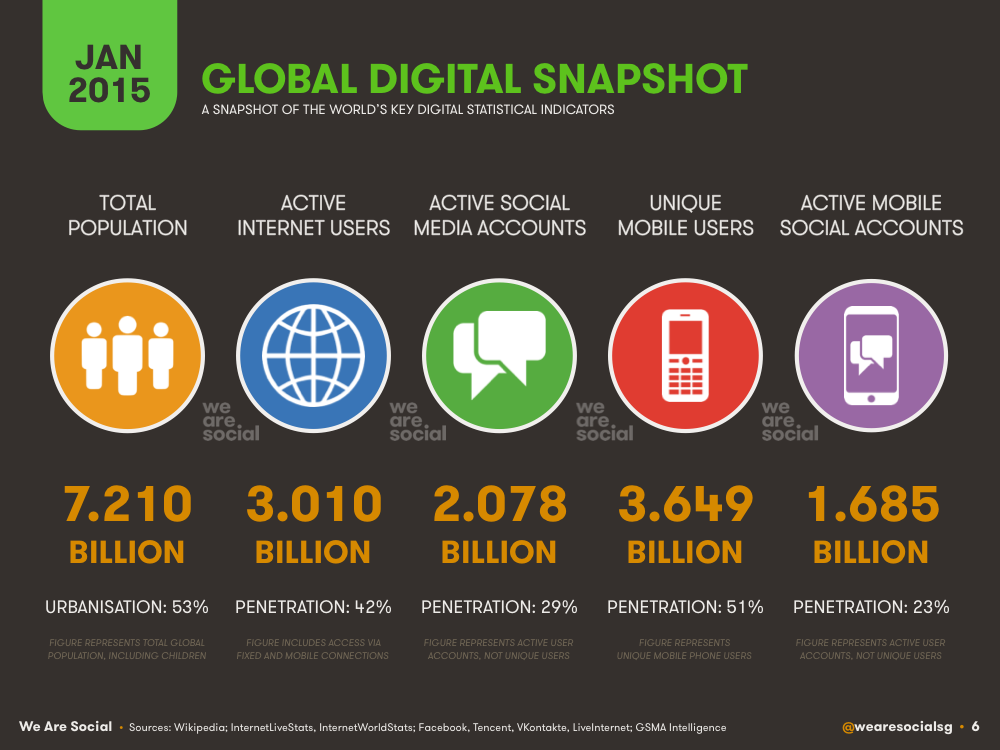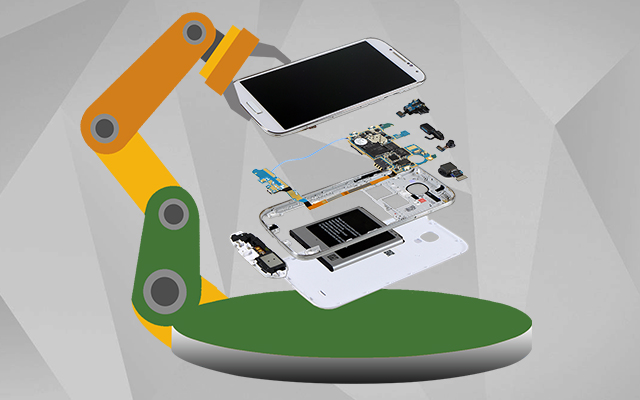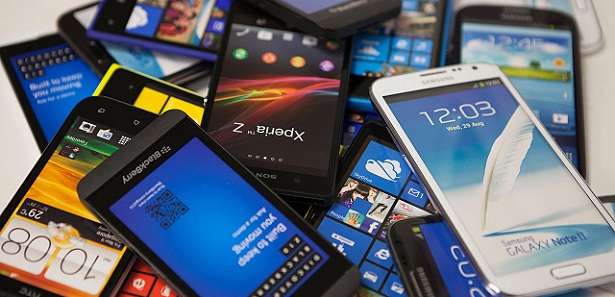The Resilient Market of Mobile Applications
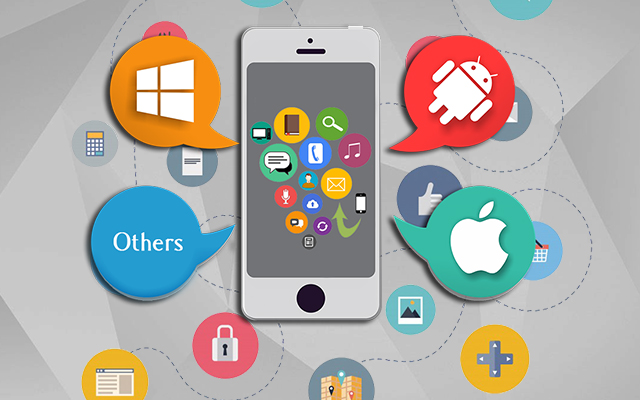
With smartphone sales climbing day by day and reaching 1441.7 million shipment in 2015, apps have also become of primary importance. Apps have become a major interface through which we interact, work and play. It has become the vital mode through which we not only interact with each other but also with businesses, social media and consumer items etc. This has further enhanced the strategic importance of the app market which spans well beyond gaming and media industries.Now with increased smartphone penetration all around the world, app will become even more important.
Globally, total time spent in apps grew by 63% on Android phones in 2015
It is expected that installed base of application will be more tan double from 2.6 billion in 2015 to 6.2 billion in 2020. Technologically the world can be divided in to two markets i-e developed markets and emerging markets. In the near future major changes can be witnessed in emerging markets where the primary growth will come from smartphone adoption. Whereas, in developed economies growth will be driven by phone replacements.
Google Play being the most popular operating system will be the primary driver of global App growth as its downloads are set to more than triple and reach 166.4 billion in 2020
Now that applications have become the go-to resource for all entertainment, productivity and communication needs, the average time spent on app have increased dramatically. According to App Annie, globally total time spent in apps grew by 63% on Android phones from 2014 to 2015. One of the major reason for this shift is the enhanced application based service offerings and engaging interfaces developed for the app ecosystem. For example dating sites are existing for years now but, the simple mechanism of a swipe made Tinder a cultural phenomenon.
App Store Downloads:
With increased popularity of applications among smartphone users, it is expected that app download will also increase and reach 147.3 billion in 2016 and 284.3 billion in 2020.
The main competition in the app market is mainly between Apple’s App store and Google’s Play store. The Apple App store allows users to browse and download applications for any of their iPhone, iPad, iPod and iWatch.
Consumer spent on app stores (gross app revenue) is estimated to grow and reach $101 billion in 2020
After the launch of Apple’s iPhone 3G in 2008 Apple opened up its Apple Store. It started out with only 500 apps but within 3 months it had seen 100 million downloads and the number of apps jumped to 3000. By the end of 2009 Apple hit 2 billion download mark, by 2010 3 billion and in 2011 10 billion with total of 350,000 apps. In March 2013, about 25 billion across 550,000 apps were downloaded. A year later in 2014, 50 billion downloads were done and by the end of 2014, 85 billion apps were downloaded from the Apple Store. Apple had around 1.5 million iOS apps available for download in the fourth quarter of 2015.
Google on the other hand launched Android Market in 2008 with very few apps to download but quickly it started to move up the leader. By 2009, Google contained about 2300 apps and in the summer of 2010 there were 80000 app available for the users to download, the total number of downloads had surpassed 1 billion mark. However, it was still long way behind Apple’s App store. During 2011 Google made progress and hit 3 billion, 6 billion and then 10 billion of total downloads.
Combined app revenue from Google Play and third-party Android stores is forecast to grow 3x from 2015 to $55.7 billion in 2020
This trend of growing apps and downloads continue to grow and in 2012 the number of apps in Google Android Market surpassed 500,000 and the total number of downloads reached 25 billion. On 6th March 2012 Google re-branded its Android Market and merged it with Google Music and Google eBookstore. The Google store managed to exceed Apple store in terms of apps available towards the end of 2014. In 2015, the Wall Street Journal reported that the Google Play had 70% more app downloads than Apple’s Play Store in the first quarter of 2014 but the revenue of Apple’s app store was about 70% higher than Google Play store. In the fourth quarter of 2015 Google Android store had around 1.6 million apps available.
Google Play being the most popular operating system will be the primary driver of global growth as its downloads are set to more than triple from 2015 and reach 166.4 billion in 2020. Meanwhile, iOS downloads are expected to grow 46% to 35.2 billion over the same time period worldwide.
App Store Consumer Spend:With massive increase in smartphone penetration and app usage, app revenues will also increase. Consumer spent on app stores (gross app revenue) is estimated to grow by 24% to $50.9 billion in 2016 and will reach $101.1 billion in 2020. Not only app revenues will increase but huge explosion in m-commerce will also take place.
There will also be a growing contribution from apps as they expand into new platforms, namely wearables, TVs, virtual and augmented reality (VR and AR), home Internet of Things (IoT) and automotive.
Leading mobile App store:On the revenue side, iOSApp Store is expected to remain the highest-grossing store through 2020, doubling from 2015 to reach $44.8 billion. However, Google Play and third-party Android stores will experience stronger growth during this timeframe, with combined revenue growing from $18.3 billion in 2015 to $55.7 billion in 2020.
Games have always been the favorite app among smartphone users and app developers alike. In 2015, 45.4 billion games were downloads that accounting for 41% of overall downloads across app stores.
Driven by surging smartphone penetration in emerging markets like India, Pakistan and Southeast Asia, game downloads are expected to hit 102.2 billion in 2020. Besides gaming apps, other app categories will also increase at a faster pace and grow from 65.7 billion in 2015 to 182.1 billion in 2020.
Growing App Revenues:Along with huge increase in downloads app revenues will also increase. Games generated approximately 85% of app market revenue in 2015, representing a total of $34.8 billion across the globe.
Games category will grow to $41.5 billion in 2016 and $74.6 billion in 2020. Meanwhile, revenue from other apps is expected to grow even faster — from $6.3 billion in 2015 to $9.4 billion in 2016 to $26.4 billion in 2020.
Although this is only one part of the monetization story in the app ecosystem. The actual value of revenues will be much higher though in-app advertising revenue which will double the size of the app market. In addition to this, we also need to take into account subscriptions paid for on other platforms but consumed through mobile apps (e.g., Netflix).
We must also consider massive transactional revenue from e-commerce, on-demand and travel commerce apps which are also not routed through app stores. Given the nature of these apps, usage is expected to be strongly correlated with revenue performance.
Emerging Mobile App market of Pakistan Pakistan is among the emerging countries where app market is going through evolutionary process. Although mobile applications are in use since the late 90s but increased smartphone penetration in the recent years has made their presence felt more deeply.
Non-game App downloads are projected to exceed 182 billion in 2020
The explosive growth of 3G/4G technology has also changed the dynamics of mobile market in Pakistan. In just two year time mobile broadband has taken over 88% of broadband market share. In December, 2015 the number of broadband subscriptions in the country surpassed 25 million for the first time out of which 23 million were mobile broadband users.
Pakistan is one of the fastest growing smartphone market in the world. Currently, almost 31% of cellular mobile handsets imported in Pakistan are smartphones, which were only about 7% in 2012
With the growing smartphone market, apps market is also growing at turbulent pace and is ready to dominate the mobile eco-system. With increased use of smartphones, mobile app usage in Pakistan has also skyrocketed, more and more people are using mobile applications. Now all kinds of applications are available including, m-health, m-education, m-government and m-commerce applications along with usual apps available in the app stores. Consumers spend more time on mobile apps rather than mobile sites and this trend has led to rapid and impressive growth of app downloads. Apps are easier to use as compared to mobile browser and enable users to get more out of their device.
Pakistan is one of the fastest growing smartphone market in the world. Currently, almost 31 per cent of cellular mobile handsets imported in Pakistan are smartphones, which were only about 7 per cent in 2012. Companies are also developing mobile app and mobile websites keeping in view the fast smartphone adoption which will further increase in future.
According to the data released by WeAreSocial in January, 2016, there are currently 126.3 million active mobile connections in Pakistan out of which 19 million are mobile social users. After smartphones surpassed computer penetration in Pakistan, smartphones have become the ultimate multi-productive gadget.
Major section of Pakistani population is the younger generation who wants to stay connected and on the top of all happenings which makes the Pakistani market ripe for data interventions and application usage.
Mobile applications have become quite popular in Pakistan and now m-services are gaining stronghold in the market. M-health, m-agriculture and m-education applications have attained huge popularity. Government has also digitalized its services through introducing various applications to offer services. Currently Punjab government is playing quite an active role through PITB. E-commerce websites like Daraz.pk, Kaymu, OLX Pakistan etc have also launched mobile applications. Telecom sector is also making use of mobile applications to enhance users experience through offering value added services. Mobile operators are not only offering special social media packages but they have also launched their own applications like My Telenor, Mobilink TV, MyWarid, UfoneCare and My Zong.
Mobile applications have become quite popular in Pakistan and now m-services are gaining stronghold in the market. M-health, m-agriculture and m-education applications have specially gained popularity
The introduction of 3G/4G technology and the penetration of smart phones in Pakistan have opened up new vistas for app developers to explore new frontiers coincide with the tight job market, pushing graduates and entrepreneurs to consider innovative business strategies in comparison of finding a place in the conventional economy. Pakistani developers are making wide range of apps including social networking, games, entertainment business and finance, navigation and utility apps, such as budgeting and data backing. In order to educate and motivate app developers Government and telecom companies such as Zong and Telenor have to step forward to uncover local talent and to spur app-making for the local market.
Apps are expanding into new devices, Apple and Google are driving development of optimized apps for VR, wearables, TVs, smart home devices and cars
App market has evolved enormously nationally and internationally alike. It has become an indispensable repository that meets our day-to-day need so it is no surprise that app usage has skyrocketed all around the world. Developers are completely aware of this explosive growth that is why they continue to develop innovative and unique apps. Furthermore, with increased mobile broadband and smartphone penetration, apps have reached critical mass. Apps are also expanding into new devices, Apple and Google are driving development of optimized apps for VR, wearables, TVs, smart home devices and cars. Internet of Things (IoT) is the new revolutionary phenomenon of which apps are the basic constituent. Right now we are in the early stages of this revolution but apps are set to become the most important interface for businesses and consumers alike. Global mobile app store downloads will reach 284 billion in 2020, so we can expect similar growth in Pakistan as well, especially when public and private companies are taking initiatives to develop a conducive environment for app developers.
Global mobile app store downloads will reach 284 billion in 2020, so we can expect similar trends in Pakistan as well
PTA Taxes Portal
Find PTA Taxes on All Phones on a Single Page using the PhoneWorld PTA Taxes Portal
Explore NowFollow us on Google News!

